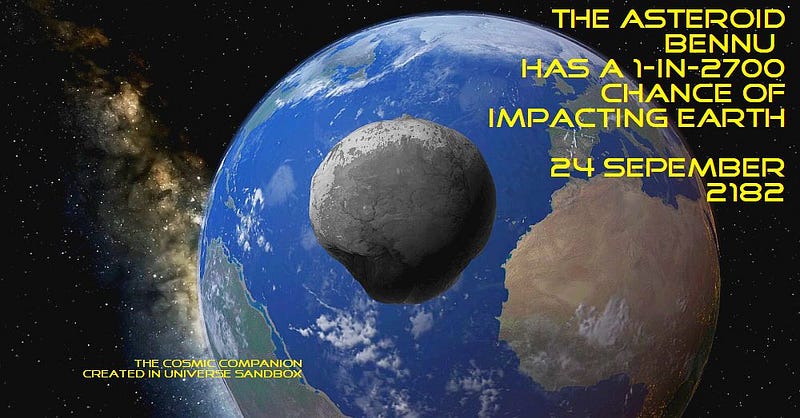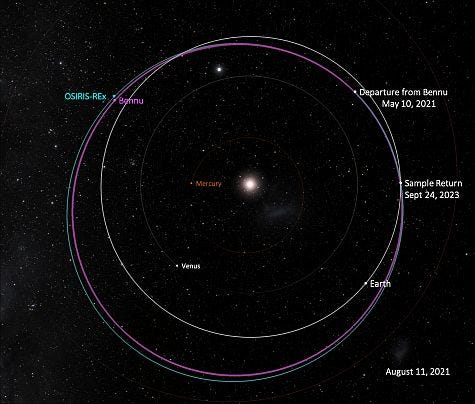# Asteroid Bennu's Potential Impact on Earth: What You Need to Know
Written on
Chapter 1: Overview of Asteroid Bennu
Asteroid Bennu, measuring approximately half a kilometer in diameter, is projected to possibly collide with Earth on September 24, 2182. Current calculations estimate its impact probability at about 1 in 2,700.

Bennu orbits the Sun in a trajectory that occasionally brings it near our planet, making it a prime candidate for robotic exploration. This close proximity also raises the risk of a potential collision.
On that date in 2182, there's a slight possibility of Bennu impacting Earth, which we will continue to monitor. An important close approach will occur on September 25, 2135, allowing astronomers to refine their predictions of Bennu’s orbit.
Section 1.1: The Importance of Close Approaches
In 2135, Bennu will come remarkably close to Earth—approximately half the distance to the Moon. This event is crucial for astronomers who will be able to calculate Bennu's trajectory more accurately.

If Bennu passes through a specific area in space known as a gravitational keyhole during this approach, it could be nudged onto a collision course with Earth in 2182. Although the odds of such an event are low, they are still significant enough to warrant attention.
Subsection 1.1.1: Understanding the Probability of Impact
Researchers estimate that the chance of Bennu hitting Earth before 2300 is about 1 in 1,750. While this is still less likely than rolling four sixes in succession, it's not negligible.
NASA says asteroid Bennu could hit earth by 2182 - YouTube This video discusses the implications of Bennu's potential impact and the calculations behind its trajectory.
Section 1.2: The Yarkovsky Effect
Calculating the orbits of asteroids like Bennu is complex due to various influencing factors. One such factor is the Yarkovsky effect, which refers to how thermal radiation affects an asteroid's orbit.
“The Yarkovsky effect causes small bodies like Bennu to drift in their orbits due to thermal forces,” researchers explain in a study published in the journal Icarus. This phenomenon is one reason behind the OSIRIS-REx mission, which aims to gather crucial data on Bennu.
NASA explains Asteroid Bennu's chance of hitting Earth in 2182 - YouTube This video provides insights into how the Yarkovsky effect influences Bennu's trajectory.
Chapter 2: The Threat of Bennu
The Yarkovsky effect applies to all asteroids, including Bennu, and is comparable to the force exerted by three grapes acting on the asteroid constantly. While this force may seem minimal, it plays a crucial role in determining Bennu's long-term trajectory.
Bennu is among the most hazardous asteroids identified, alongside 1950 DA. With a diameter of about half a kilometer, a collision would not cause a global extinction event, but it could lead to widespread devastation.

Predictions suggest that an impact could create a crater measuring between five to ten kilometers (three to six miles) wide, with significant damage extending hundreds of kilometers from the impact site.
The OSIRIS-REx mission, which orbited Bennu for two years, successfully collected a sample on May 10, 2021. This sample is expected to arrive on Earth for analysis on September 24, 2023, precisely 159 years before the potential impact date.
“Data from OSIRIS-REx will enable us to refine our models and predict Bennu’s trajectory with unprecedented accuracy through 2135,” states Davide Farnocchia, an asteroid dynamicist at the Center for Near-Earth Object Studies.
Even with the current knowledge, the future of Bennu remains uncertain. While its trajectory will be closely monitored, there's no need to panic about its potential impact in 2182.
James Maynard is the founder and publisher of The Cosmic Companion. He currently resides in Tucson, Arizona, with his wife, Nicole, and their cat, Max. Did you enjoy this article? Join us on The Cosmic Companion Network for our podcast, weekly video series, informative newsletter, and more!